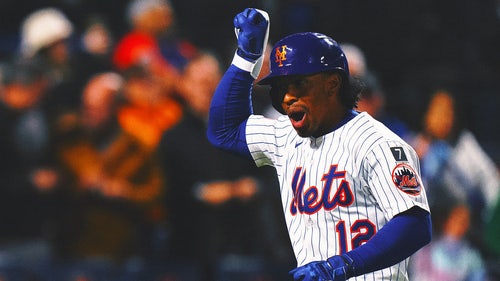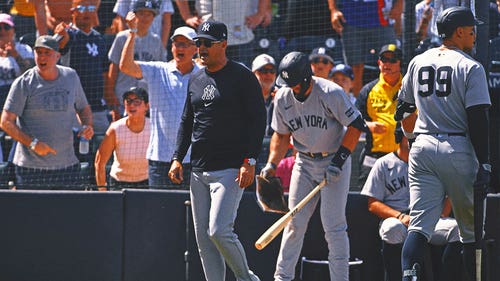
Unlucky Kershaw will be just fine
Clayton Kershaw is in unfamiliar territory. The three-time Cy Young Award winner and consensus best pitcher in baseball finds himself sporting a 4.24 ERA in mid-May, prompting questions about what might be wrong. Luck has largely been unkind to Kershaw in 2015, and he’s due for a big regression toward better numbers. However, he hasn’t been the Kershaw we’ve seen for the past two years in one important part of his game, and that has led to some poor results.
Pitchers can’t control everything on the baseball field. After the ball leaves their hand, control is ceded to the batter, the defense and luck. Chief among the factors pitchers have little control over: the rate of men they leave on base, the rate of balls in play that go for hits, and the rate of flyballs that go for home runs. Metrics like FIP (Fielding Independent Pitching) and xFIP try to take out a lot of the variability in a pitcher’s stat line influenced by things outside of their control, attempting to measure only what the pitcher is responsible for.
Kershaw has been a victim of some of those factors in 2015. First, there’s the rate of balls in play that have actually gone for hits. Here’s a chart of Kershaw’s batting average on balls in play against him over the course of his career compared to league average:
This year batted balls have been finding holes in the infield and gaps in the outfield, something Kershaw doesn’t have much control over. Once those batted balls start finding gloves, they’ll start getting turned into outs more often.
Kershaw’s rate of runners left on base in 2015 has been unlike years past as well. Here’s a chart of the rate at which he’s stranded runners on base over his career compared to league average:
He’s always had a penchant for stranding a higher number of runners than a league average pitcher, mostly due to his great strikeout ability (which makes getting out of jams easier because he doesn’t have to rely on defense or batted-ball luck).
Looking at these factors, as well as his velocity (which has actually been higher so far than in years past), it can be concluded that 2015 Kershaw is close to vintage Kershaw — he’s due for a big regression in those inflated statistics. However, that conclusion also ignores a key aspect to his season so far, one summed up in a quote from him last week:
“... for me, my pitch execution hasn't been good. That's what I look at. I know, for me, I haven't pitched as well as I can."
What does Kershaw mean by pitch execution? Here’s a home run that Troy Tulowitzki hit off of the Dodgers left-hander, a 1-2 fastball, on April 17 — pay attention to the location of the glove and then where the pitch ends up:
Catcher Yasmani Grandal wanted the ball in. Instead it ended up out over the middle of the plate. To be fair, the ensuing line drive just cleared the fence, but still — the pitch was a mistake to a great hitter and it got hit hard.
Here’s another example, a first-pitch fastball to Buster Posey on April 28. Again, pay attention to the glove, and then the location of the pitch:
Catcher A.J. Ellis wanted the ball inside. Kershaw left it out over the plate. All pitchers miss spots, and all pitchers give up home runs. Kershaw has just happened to miss spots against some of the best hitters in the game and they’ve made him pay for it. These are just a few examples, but this is indicative of what Kershaw means when he talks about pitch execution: As the best pitcher in the game, he’s not used to balls leaking over the plate when he doesn’t mean them to. At times, that’s exactly what has happened this season.
That brings us to the root of the home run problem Kershaw has had this year. Look at the percentage of flyballs that have gone for home runs over his career compared to the league average in those years:
He’s shown an ability to suppress home runs during his career, mostly due to making hitters generate weak contact. That has done a complete 180 this year, as his home run/flyball rate has rocketed to 18.5 percent. A lot of that is luck; only two of the five homers hit off of Kershaw this year have travelled over 400 feet (one of those wouldn’t have left the yard in half of MLB stadiums). However, the locations of the pitches above hit for home runs were poor, and that's one of the reasons they got hit hard.
Another thing to note: Three of the homers he has served up this season occurred on the first pitch. There’s something to that. Here’s a map of the location of first pitches Kershaw threw to right-handers in 2014 vs. the 2015:
They’re more centralized this year, and they’re also higher up in the zone. Hitters tend to jump on belt-high, first-pitch fastballs in the middle of the plate and that shows in Kershaw’s stats this year. Even though hitters are swinging on his first pitches at the same rate as last year (around 22 percent), they’re going for hits more often. Hitters have already compiled 14 hits off of Kershaw first pitches in 2015; he gave up a total of 32 all of last year. Some of that can be blamed on Kershaw’s lack of luck on batted balls so far this season, but it’s telling that he’s already given up as many home runs on first pitches as he did in all of 2014.
When the best players in baseball don't perform as expected, even for a short period of time, it stands out. Kershaw is still incredible — he’s striking out more batters than he ever has, he’s been on the receiving end of some really bad luck in the early going, and he’s healthy. Fans most likely won’t even remember that anything was “wrong” with him when the season ends. Kershaw is right: He can pitch better than he has so far in 2015. He's done it before and he'll do it again.











